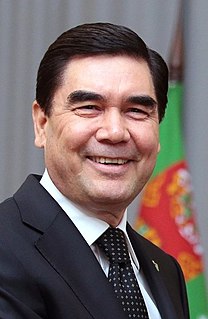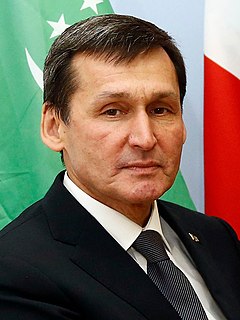
The politics of Turkmenistan takes place in the framework of a presidential republic, whereby the President of Turkmenistan is both head of state and head of government. However, no true opposition parties are allowed; every registered political party supports the third and current President Serdar Berdimuhamedow. The country is frequently described as a totalitarian state.

Ashgabat or Asgabat, is the capital and the largest city of Turkmenistan. It is situated between the Karakum Desert and the Kopet Dag mountain range in Central Asia. It is also near the Iran-Turkmenistan border.

Turkmenistan, also known as Turkmenia, is a landlocked country in Central Asia, bordered by Kazakhstan to the northwest, Uzbekistan to the north, east and northeast, Afghanistan to the southeast, Iran to the south and southwest and the Caspian Sea to the west. Ashgabat is the capital and largest city of the country. The population of the country is about 6 million, the lowest of the Central Asian republics. Turkmenistan is one of the most sparsely populated nations in Asia. Citizens of Turkmenistan are known as Turkmenistanis, Turkmenians or Turkmens.

Ahal Region is one of five provinces of Turkmenistan. It is in the south-center of the country, bordering Iran and Afghanistan along the Kopet Dag Range. Its area is 97,160 km2 (37,510 sq mi) and population 939,700.

Turkmenistan is divided into five regions or welaýatlar and one capital city (şäher). They are Ahal, Balkan, Dashoguz, Lebap and Mary, plus the capital city of Ashgabat. Each province is divided into districts. As of January 1, 2020, there were 43 districts, 51 cities, including 11 cities with district status, 62 towns, 504 rural councils and 1717 villages in Turkmenistan.

The president of Turkmenistan, officially the president and chairman of the Cabinet of Ministers of Turkmenistan, is the head of state and head of government of Turkmenistan. The president is also the supreme commander in chief of the Armed Forces of Turkmenistan and heads the State Security Council.

The People's Council of Turkmenistan is the upper chamber of Turkmenistan's Parliament, the "National Council". It consists of 56 members, 48 elected from the five provinces and the capital city of Ashgabat, and 8 appointed by the president.

The Assembly is since March 2021 the lower house of the National Council of Turkmenistan. It has 125 members, elected for five-year terms in single-seat constituencies.

Gurbanguly Mälikgulyýewiç Berdimuhamedow, also known as Arkadag, is a Turkmen politician who served as the second president of Turkmenistan from 2006 to 2022.

The districts of Turkmenistan are territorial entities below the provinces of Turkmenistan. They may be counties, cities, or boroughs of cities. The heads of the districts are appointed by the President of Turkmenistan.

The following outline is provided as an overview of and topical guide to Turkmenistan:

Raşit Öwezgeldiýewiç Meredow is a Turkmen politician and diplomat who has served as Vice President of Turkmenistan since 2007.
Baherden District is a district of Ahal Province, Turkmenistan. From 2003 to 2018 it was named Baharly ("spring-like") District.

The list of Turkmenistan-related articles is below
Turkmen National Conservatory is a music conservatory in Ashgabat, Turkmenistan. Based on the decree № 1403 of the President of Turkmenistan from June 2, 1993, Ashgabat State Conservatory was transformed into Turkmen National Conservatory (TNC). Now TNC is one of the leading institutions of higher education in the country. Turkmen National Conservatory is under the direct patronage of the Ministry of Culture and Broadcasting of Turkmenistan.

The Internal Troops of Turkmenistan is a service branch of the Armed Forces of Turkmenistan under the auspices of the Ministry of Internal Affairs. It is one of three types of paramilitary forces in the country, with the other two being the Turkmen National Guard and the Turkmen Border Troops. It is designed to maintain law and order and enforce the status quo in terms of state sovereignty. It aides the Turkmen National Police in everyday activities, similarly to the Military Police Corps in the United States Army. In an operational view, the internal troops are organized similarly to the Turkmen Ground Forces, both consisting of sub-units. The Internal Troops consists of between 20,000 and 25,000 personnel.

The Supreme Court of Turkmenistan is a constitutional institution in Turkmenistan. It is one of three Turkmen institutions to exercise governmental power and is the highest ranking court in the country. Established in 1992 after the adoption of the Constitution of Turkmenistan, the Supreme Court currently consists of 22 judges who are appointed by the President of Turkmenistan for a 5-year term. It is the successor to the Supreme Court of the Turkmen SSR. The associate judges are divided into three different chambers, each specifically focusing on civil, criminal, and military law. The Supreme Court is affiliated to different regional munincipal, provincial courts, district and city courts, as well as the Supreme Economic Court.

People's Council elections were held in Turkmenistan on 28 March 2021 to elect 48 of the 56 members of the People's Council or Halk Maslahaty. Another eight were appointed by the president on 14 April 2021.

Early presidential elections were held in Turkmenistan on 12 March 2022. The elections were called after incumbent president Gurbanguly Berdimuhamedow announced his intention to resign.














